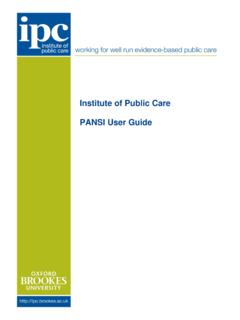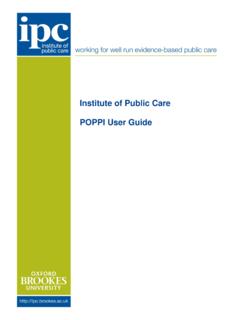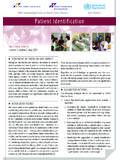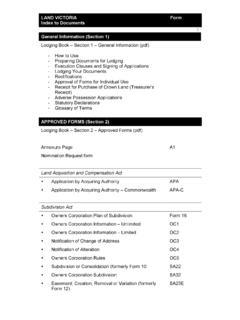Transcription of PANSI User Guide - POPPI
1 Care Services Efficiency Delivery Demand Forecasting and Planning PANSI user Guide PANSI stands for Projecting Adult Needs and Service Information. It gives easy access to projections of the numbers, characteristics and care needs of people aged 18-64 in England at national, regional and council level. With POPPI covering the over 65 age bands, POPPI and PANSI bring together relevant information for council planners and commissioners of adult social care and provide a consistent starting point for Joint Strategic Needs Assessment. PANSI 3 introduced a new, wider screen, format showing: Comparator' authorities using the CIPFA model A Neighbours' menu for adjoining councils Government Office Region and other authorities in the GOR. Users own groups of up to 15 councils, regional and England totals PANSI 4 gave users the ability to compare data across councils, regions and the new menu groups to download data for many geographical locations.
2 PANSI introduces: an interactive map for navigation to councils, districts and regions ONS population projections for the City of London and the Isles of Scilly new prevalence data for Challenging Behaviour a new mental health category of Psychiatric Co-morbidity people receiving Disability Living Allowance in 2010. people subject to Guardianship in 2010. POPPI and PANSI use ONS forecasts based on current trends. They do not predict expected' outcomes. Often, the strategic direction will aim to avoid the outcomes that PANSI projects through service transformation. [See Using PANSI ' below]. POPPI and PANSI are developed and supported by the Department of Health CSED. Programme and the Institute of Public Care, Oxford Brookes University [IPC]. PANSI user Guide Page 2.
3 registering WITH PANSI . POPPI users are already registered. They can access PANSI with their POPPI . registered e-mail address and password. If you are not registered to use POPPI , go to , choose 'Click here to register' and complete the on-line form with: Name, job title and organisation Office address and phone number Email address PANSI automatically sends a unique password to local and national government, NHS or academic e-mail addresses. For other e-mail addresses, please supply the additional information requested to facilitate your registration: Service providers: are you registered with CQC? Charities: please give your registered charity number. Others: please state why you wish to use PANSI and POPPI . When your registration is accepted, a password is sent to your e-mail address.
4 Once logged-in, you can change your password using the My account' screen from the menu top right. There is a forgotten password link on the login page. Your password, with the registered e-mail address as your username, allows you to access both POPPI and PANSI from any location. In PANSI and POPPI , links allow you to switch between the sites where tables have the same content. This makes it easy to view data for all adult age-bands and the total population forecast. The login page also has information on recent and planned updates to the data and the system and a link to download the user Guide . If you have any problems or queries, contact the Institute of Public Care: Telephone 01225 484088 (9am to 5pm Mondays to Fridays) and ask for the helpdesk OR email Changes from PANSI Version are highlighted in this user Guide .
5 Care Services Efficiency Delivery (CSED) December 2010. PANSI user Guide Page 3. POPULATION PROJECTIONS. After logging in, you will see the Office for National Statistics [ONS] population projections for your council. For non-council users, the screen displays the results for England - but users can now nominate their own default locality through My account'. This is an example of the baseline population forecast table by age in PANSI . PANSI uses ONS Subnational Population Projections, published 27 May 2010. Long-term population projections are an indication of the trends in population by age and gender. They are based on 2008 mid year population estimates and assumptions on future levels of births, deaths and migration based on observed levels mainly over the previous five years.
6 They show what the population would be if recent trends continue and do not take into account future policy changes. Care Services Efficiency Delivery (CSED) December 2010. PANSI user Guide Page 4. Population figures On the left hand side of the screen, menu options under Population figures lead to tables for: Population projections by age for 2010, 2015, 2020, 2025, 2030. Population by age and gender 2007 Population by ethnic group - numbers and percentages. [ PANSI uses the experimental ONS estimates by age band published in April 2009.]. Disability Living Allowance The final option in the Population figures' menu is a table of actual Disability Living Allowance (DLA) cases in payment, by age-band. The data is from DWP, Disability Living Allowance Caseload by local authority of claimant, by age and is now updated with data for May 2010.
7 The active menu button is marked with a blue dot. Percentage change Select Show percentage change' on the Population by age and Population by gender and age pages to show the projected percentage change from the current year [2010] to 2015, 2020, 2025, 2030. Show numbers' reverts to the projections. Near-term population projections Choose 'Show next five years' to display population projections for the next 5 years 2010, 2011, 2012, 2013, 2014. Choose 'Show 2010 to 2030' to return to 2010, 2015, 2020, 2025 and 2030. The Notes on each page identify data sources with tables of the prevalence rates used. The rates and source references are downloaded with the projections when the Download facility is used. Councils should make judgements about the relevance of the prevalence rates used to their locality.
8 Care Services Efficiency Delivery (CSED) December 2010. PANSI user Guide Page 5. NAVIGATION TO OTHER GEOGRAPHICAL LOCATIONS. With Menus You can view information for any local authority, district, Government Office Region (GOR) or for England as a whole. Councils with social services responsibilities are listed in alphabetical order in the drop-down menu top right with England and the 9. GORs at the top. To change location, on any page, use the drop down list [top right] to list locations;. highlight the required location and then click once to display the data. To view district data, choose the relevant county council as above, then use the drop- down Select a district' menu immediately beneath, to select the district required. In PANSI , menu groups make it easier to navigate to other relevant councils.
9 Choose Go to a comparator' for each authority's closest fifteen comparators using the CIPFA Nearest Neighbour' Model useful for benchmarking. Choose Go to a neighbour' to list councils adjoining the selected authority . useful for coordinating strategy and potential cross-border impacts. Region' allows users to select authorities in their GOR and the regional total. Users can also build up three of their own Favourites' groups of up to 15 localities from local authorities, GORs and England. To add, remove and name selections use the Organise favourites' menu on the right. [See Facilities section for more details.]. PANSI uses district data to provide a planning base for the four new unitary authorities in Bedfordshire and Cheshire. District level detail is retained for the five counties that have converted to unitary authorities.
10 PANSI includes population projections for the City of London and the Isles of Scilly with their neighbours and other authorities in the London and South West Regions respectively. Data for Cornwall now excludes the Isles of Scilly. CIPFA comparators are not yet available for the City and the Isles of Scilly. With Maps Users can navigate between geographical areas using a map covering England, the regions, unitary authorities, counties and districts. Choose Show map' below the drop down menu top right to display a map. Click on the map to select a location. Use the map menus to move up from districts to counties and up from authorities to regions. Choose Close map' to close the map and view data for the selected location. Users can move across the country as well as focus in on areas where authorities are densely packed, for example, in the Greater Manchester area.






